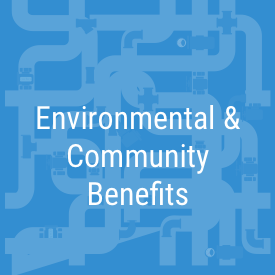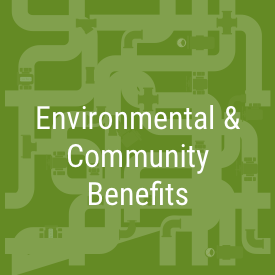In partnership with the South Bay Salt Pond Restoration Project (SBSPRP), the largest marsh restoration project, the Calabazas/San Tomas Aquino Creek-Marsh Connection Project aims to restore creek-marsh connections and tidal flows to establish 1,800 acres of tidal marsh in A8 Ponds and Pond A4. The restored tidal marsh is expected to keep pace with sea level rise, providing resilient flood protection. The realigned creek channels will have improved flow lines, reducing the need for future channel maintenance. The project is located at the southern end of the San Francisco Bay and northern shoreline of Santa Clara County and will benefit the cities of Sunnyvale, Santa Clara and San Jose, including the community of Alviso. (Download Project Fact Sheet)
The Calabazas/San Tomas Aquino Creek-Marsh Connection Project has many stakeholders including the U.S. Fish and Wildlife Service, California State Coastal Conservancy, Caltrans, the County of Santa Clara, and the cities of San Jose, Santa Clara, and Sunnyvale.
The project’s main objectives are to:
- Ecologically restore and enhance the tidal and freshwater marsh and river habitat at the project area.
- Provide resilient flood protection that will adapt to projected sea level rise.
- Reduce maintenance needs for lower Calabazas and San Tomas Aquino creeks.
- Provide enhanced public access and trail improvements.
Current Project Phase:
Planning
Schedule:
Planning: Spring 2022-Spring 2025
Design: Summer 2025-Summer 2027
Construction: Fall 2027-Fall 2029
Current Estimated Cost:
Planning through Design Phases: $10 million
Grant Funding:
Measure AA administered by San Francisco Bay Restoration Authority: $3.37 million
Prop 1 Grant administered by California Department of Fish and Wildlife: $500,000
San Francisco Bay Water Quality Improvement Grant administered by U.S. Environmental Protection Agency: $3,800,000








Past Public Meetings
On May 15, 2024, Valley Water held a public meeting to present the Calabazas/San Tomas Aquino Creek-Marsh Connection Project. The presentation covered a project overview, conceptual alternatives and was followed by a question-and-answer session.
On May 16, 2023, Valley Water held a public meeting to present the Calabazas/San Tomas Aquino Creek - Marsh Connection Project. The presentation covered a project overview, five conceptual alternatives and was followed by a question-and-answer session.
- Resilient Landscape Vison for the Calabazas Creek, San Tomas Aquino Creek, and Pond A8 Area - https://www.sfei.org/sites/default/files/biblio_files/CalabazasVision_SFEI_061118_highres.pdf
- Calabazas and San Tomas Aquino Creek Realignment Project Final Feasibility Report - https://fta.valleywater.org/dl/EnrnItey2a
- Sunnyvale Shoreline Resilience Vision - https://fta.valleywater.org/dl/RSwC40GAyZ
- Phase 2 Alviso/Ravenwood Final Environmental Impact Statement Report - https://www.southbayrestoration.org/document/phase-2-alvisoravenswood-final-environmental-impact-statementreport
- Phase 1 - Feasibility Study of Effect of Pond A8 Restoration and Realignment of Calabazas Creek and San Tomas Aquino Creek on Peak Water Levels - https://fta.valleywater.org/dl/ro76GnVJP1
- Phase 2 - Feasibility Study of Effect of Pond A8 Restoration and Realignment of Calabazas Creek and San Tomas Aquino Creek on Peak Water Levels - https://fta.valleywater.org/dl/of8ulG3exX
- Conceptual Alternative Report
The Project will restore and enhance up to 1,500 acres of tidal marsh, seasonal, and brackish marsh and riparian habitat. The self-sustaining tidal marsh will provide more than natural resilient flood-protection. The connected creek-marsh-bay system will benefit native fish and wildlife, including, federal and state Endangered Species Act-listed species, such as the Ridgway’s rail, salt marsh harvest mouse, and Central California Coast steelhead.
Project benefits will include enhanced opportunities for public access to the area promoting environmental education and recreation. Nearby communities including Alviso, a historically disadvantaged community suffering from a history of disinvestment and social injustice will benefit from resilient flood protection and enhanced public access to the restored natural tidal marsh. Economic benefits to the Alviso community will include construction period expenditures in the short term and increased recreational use of the area in the long-term. The Project would also benefit the regional economy by reducing future creek maintenance costs. The expected savings from avoidance of flood damage would be substantial, especially given the tremendous amount of high value property development in this portion of Silicon Valley.
The project was formerly known as the Salt Ponds A5-11 Project and changed to current name to better highlight the project purpose and align with regional documents such as the 2015 Baylands Goals update and Sediment for Survival. Previously the Salt Ponds A5-11 project focused on our strong partnership with SBSPRP and USFWS and Valley Water’s support to provide dirt to USFWS to maintain the existing berms around Ponds A5-11 to prevent degradation in current levels of de facto flood protection that the former salt ponds provide. With construction of Phase 1 of the Shoreline Project now underway to provide flood protection to the Alviso area, USFWS is now shifting focus with a stronger intent to restore the A8 Ponds.
The A8 Ponds were once tidal marshes that were converted to salt production ponds and diked off from the Bay more than a century ago. The Calabazas and San Tomas creeks used to discharge into tidal marshes at the edge of the San Francisco Bay but were realigned years ago to bypass the ponds and discharge directly into Guadalupe Slough and the bay. This resulted in unnatural flow lines with sharp bends that reduced the amount of water that flowed through the creeks and resulted in large deposits of sediment in the channels. Valley Water periodically removes the accumulated sediment at great expense to keep the channels free and prevent increased flood risks to local development. Valley Water’s project is now focused on connecting Calabazas and San Tomas creeks to the A8 Ponds to create a tidal marsh habitat.
The project will be the first creek-marsh connection project in the lower South Bay and has received significant grant funding for the planning through design phases

